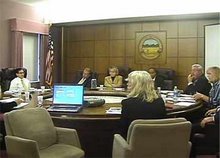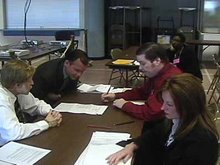Brunner Seeks Proposals to Test Voting SystemsCOLUMBUS, Ohio — Secretary of State Jennifer Brunner on Monday sought proposals from experts to test the capability and security of the voting machines used in Ohio.
According to the Request for Proposals released by Secretary Brunner, system evaluations will examine the technology of the touch-screen and optical scan machines as well as the software. The evaluation will also conduct volume and usability testing on each election system.
The evaluation, expected to begin in mid-summer and to be completed in the fall of this year, advances a top priority of Secretary Brunner's: Improving the integrity of and bolstering public confidence in Ohio's elections. Proposals are due by July 9, the Secretary of State's office said.
The results of the testing process will be used to make improvements in the handling and securing of voting machines before, during and after elections, the Secretary of State's office said.
“This is a vital step to assuring voters that Ohio's elections are safe, reliable and accurate and that the results can be trusted,“ said Brunner, Ohio's top elections official.
“With Ohio's pivotal role in the last presidential election and the likely emphasis that will be placed on our vote in the next, we owe it to our state and the nation to bring in the best experts available to examine these systems,“ said Brunner.
“If problems are detected, we will work to find a solution. We will also gain valuable insight to improve election security procedures to ensure the integrity of our vote,“ Brunner added.
The testing seeks a comprehensive, independent and objective assessment of the risks to election integrity associated with Ohio's voting systems. The three manufacturers of voting systems in Ohio are Election Systems & Software; Diebold Election Systems and Hart InterCivic.
Testing is expected to be complete by Sept. 20, 2007 or as mutually agreed upon by the Secretary of State's office and the experts who are selected, according to the request.
">To view the RFP, click here (PDF).
">To view a county by county map of Ohio's voting systems, click here (PDF).
">To view facts about the EVEREST project and the RFP, click here (PDF).
-30-
Media Contacts:
Patrick Gallaway, Director of Communications, (614) 752-2450
Jeff Ortega, Assistant Director of Communications, Media: (614) 466-0473.Well I don't know about this. The goals could get very mirky here for they don't start out very clearly, in my opinion.
I don’t understand why we keep avoiding the basics.
- Why we’re not getting systems designers first find out what is needed for fair, accurate, transparent elections, then bring in the computer scientists to decide how these machines pose risks to those basic needs/ thus what needs to be developed.
- Or why we keep starting from the massive security and operational limits of the machines, to see how we might “mitigate” risks – when such mitigations have proved also too costly, only partially reliable (leaving the other parts able to improperly sway elections) and completely impractical to rely upon for the decisions of who will be our next president etc.
I do wish this project great success. But I also wish this office would define/take a clear stance on such things as
We'll be following this one closely to see if it helps or further hinders democracy.....
- election integrity
- accuracy - ( not as some expert’s mathematical probability, especially not in some audit that takes place after some election, mainly to pacify the people still disgruntled that we still can't see votes being counted; we still can't count them ourselves if we wanted to (we can only look at some long skinny paper tapes that some other secret software told the machines to print something on) - but as accuracy as we all know accuracy)
- transparency – so we all can verify our votes in ways that make sense to human minds, make sure that results make sense, and can watch our votes being counted – not have them announced from some secret software that we’re only told “just counts,”or by some other “experts” who looked at probabilities and mitigations
- independent – to stop this burgeoning of computer “experts” and academics eager to build whole new careers, on more billions of our money over this 2002 HAVA fiasco and the impossible-for-fair elections machines it's left us with throughout the nation.
When will enough be enough? Who will finally say it- ENOUGH!
Let's cut our massive and continuing losses, and get on with teh business of democracy!
Tuesday, June 19, 2007
Secretary Brunner Starts Process of Testing Electronic Voting Systems
http://www.sos.state.oh.us/News/Read.aspx?ID=203
Subscribe to:
Post Comments (Atom)






No comments:
Post a Comment